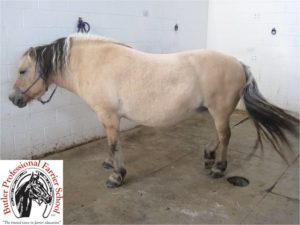Dangers of Overfeeding

This horse would benefit from a diet to reduce the stress on the foot structures and prevent a disastrous acute founder attack.
Many problems with horses are caused by horse-loving people. Perhaps the most disturbing is the harmful, yet common notion, that “food is love.” There are far too many cases of young horses crippled with developmental orthopedic disease resulting in club foot, epiphysitis and secondary hyperparathyroidism. Many older horses are afflicted with low ringbone, navicular disease and, worst of all, laminitis and founder. Many of these conditions could be prevented or cured if horse owners would pay more attention to a horse’s condition and restrict its diet.
A horse is a combination of genetics and environment. When selecting for one trait over others, you typically get what you select for. However, strength in one trait often means weakness in others. When you add a faulty environmental component, it’s a recipe for disaster.
For example, for the last 30 years or so it has been popular to breed for rapid growth — producing maximum height at an early age. However, it has been shown in numerous controlled studies at various universities that feeding concentrated energy and excess protein to maximize a horse’s growth potential causes all sorts of developmental abnormalities and limb diseases (E.A. Trowbridge & D.W. Chittenden, University of Missouri, 1932; H.F. Hintz, Cornell, AAEP 24:455-459, 1978). When you add excess energy in the form of grain and high protein alfalfa hay to the genetic component, the result is often a crippled horse. Unfortunately, these findings are largely ignored by people in the show horse industry.
Horses with extremely steep limb angles, especially of the pasterns and hocks, may also inherit under-run heels. The combination of concussion produced by the steep angles, and the added stress upon the deep flexor tendon and navicular bone region produced by the low heels producing a de-rotated coffin bone, is a predisposing formula for severe lameness.
The first thing to consider when formulating a diet for a horse is the amount of feed given. Non-working horses should be fed about 1½ to 2 percent of their body weight. You can determine a horse’s body weight with a weight tape if a scale is unavailable.
For example, if a horse weighs 1200 pounds, then it should be fed 18 to 24 pounds per day. If a small square bale weighs 60 pounds, you should feed about 20 pounds or about one-third of the bale per day. This works out to 1/6th of a bale per feeding, or 10 pounds. Grain should be used sparingly as a carrier for medicine or supplements and as a reward for catching or training – not as a part of the regular diet.
Young horses may develop epiphysitis as a result of too much energy feed (like grain) in the diet. The growth plates of the long bones become inflamed and the joints swell up. This typically happens in the fetlock region where the growth plate on the proximal end of the long pastern bone (P1) and the growth plate on the distal end of the cannon bone (Mc3/Mt3) meet. Those growth plates close at approximately 6 months and 9 months respectively. A horse that is being weaned around that time may have its diet supplemented with grain but if too much grain is given, the horse can develop this serious condition. The swelling of the fetlocks goes down quickly when the feed ration is corrected. It is important to feed horses the correct amount!
A horse’s weight can be monitored visually using a 10-point scale developed at Texas A & M University. The ideal working horse is a “5.” A “5” is a horse on which you can’t see the ribs but you can feel them. A “1” is a horse that is skin and bones, a “10” is a horse that is roly-poly fat. A horse in good condition is a “6.”
Careful monitoring and calculating of feed amounts is important for domesticated horses. You can best prove your love for your horse by calculating and feeding it a reasonable ration that is healthy for it. Over-feeding it is not love! Doing so may cut your horse’s career short and subject it to a life of pain, veterinary treatment and therapeutic shoeing.
Related Posts
-
Hoof wall thicknesses vary. There is a very small margin for...Jan 22, 2010 / 0 comments
-
Farriers are presented with different horse feet scen...Oct 27, 2016 / 0 comments
-
One of the most rewarding benefits to me in conducting closi...Aug 03, 2011 / 0 comments
Blog Categories
- Anatomy
- Best Business Practices
- Conformation
- Current Events
- Customer Service
- Draft Horse Shoeing
- Equine Soundness
- Essential Anatomy Kit
- Farrier Careers
- Farrier training
- Foal soundness
- Horse Care
- Horse Foot Care
- Horse Owner Tips
- Horsemanship
- Horseshoeing
- Horseshoeing History
- Iron and Forge Work
- Student Spotlight
- Uncategorized
- Veterinary Care
Blog Archives
Contact Us
Butler Professional Horseshoeing School
495 Table Road
Crawford, NE 69339
(800) 728-3826
jacob@dougbutler.com
Subscribe to Our Blog
Get Our Free e-Book!
If you think you want to become a farrier (or know someone who does), this book can help you make that decision. Horse owners will learn the importance of choosing a qualified farrier and how to select the “right” one.
[ Get the e-Book Now! ]
- Follow:
